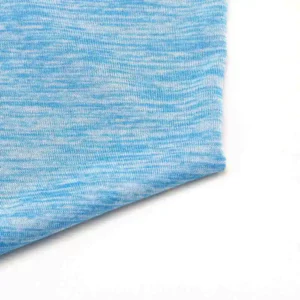Using reflective fabric materials in safety apparel offers several advantages:
- Increased Visibility: Reflective fabric materials contain retroreflective elements that reflect light back to its source, making wearers more visible in low-light conditions or at night. This increased visibility enhances safety by alerting drivers, equipment operators, and pedestrians to the presence of workers or individuals wearing reflective apparel.
- Enhanced Safety: Reflective fabric materials help reduce the risk of accidents and collisions by improving the visibility of workers in hazardous environments, such as construction sites, roadways, and industrial facilities. By increasing visibility, China fabric material reflective apparel enhances situational awareness and allows for timely identification of personnel in high-risk areas.
- Compliance with Safety Regulations: Many occupational safety standards and regulations require workers to wear high-visibility apparel in certain environments, such as construction sites, highways, and railway yards. Reflective fabric materials help meet these regulatory requirements by providing the necessary level of visibility and ensuring compliance with safety standards.
- Versatility: Reflective fabric materials can be incorporated into a wide range of safety apparel, including vests, jackets, pants, shirts, and accessories. This versatility allows for customization of safety gear to meet the specific needs of different industries and job roles while maintaining the required level of visibility.
- Durability: Reflective fabric materials are designed to withstand harsh environmental conditions, including exposure to sunlight, moisture, chemicals, and abrasion. High-quality reflective materials maintain their reflective properties over time, ensuring long-term visibility and durability of safety apparel in demanding work environments.
- Day-Night Visibility: Reflective fabric materials provide visibility both during the day and at night, enhancing safety in all lighting conditions. In daylight, the fluorescent background of the fabric increases visibility, while the reflective elements reflect light from headlights, streetlights, or other sources in low-light or nighttime conditions.
- Worker Confidence: Wearing safety apparel made from reflective fabric materials can increase worker confidence and peace of mind, knowing that they are visible and protected in hazardous environments. Enhanced visibility reduces the risk of accidents and injuries, contributing to a safer work environment and improving overall morale among workers.
- Branding and Identification: Reflective fabric materials can be customized with logos, slogans, or identification markers to promote company branding and enhance recognition of personnel in the field. Customized reflective apparel not only improves visibility but also reinforces corporate identity and professionalism.
Overall, the advantages of using reflective fabric materials in safety apparel include increased visibility, enhanced safety, compliance with regulations, versatility, durability, day-night visibility, worker confidence, and branding opportunities. By incorporating reflective materials into safety apparel, employers can provide effective protection for workers in high-risk environments and reduce the likelihood of accidents and injuries.
What role do fabric materials play in the design of soft furnishings and decor?
Fabric materials play a significant role in the design of soft furnishings and decor, contributing to both aesthetic appeal and functional performance.
Here are several key roles fabric materials play in soft furnishings and decor:
- Upholstery: Fabric materials are commonly used for upholstering furniture such as sofas, chairs, ottomans, and benches. Upholstery fabrics come in a wide range of textures, patterns, colors, and materials, allowing designers to achieve various styles and aesthetics. Fabric upholstery adds warmth, comfort, and personality to furniture pieces while providing durability and ease of maintenance.
- Drapery and Curtains: Fabric materials are essential for creating drapery and curtains, which enhance the ambiance and functionality of interior spaces. Drapery fabrics come in different weights, opacities, and designs to provide privacy, light control, and decorative accents. From sheer and lightweight fabrics for a soft, ethereal look to heavy and opaque fabrics for light-blocking and insulation, fabric drapery plays a vital role in interior design.
- Pillows and Cushions: Fabric materials are used for making pillows, cushions, and throw blankets, adding layers of texture, color, and comfort to seating areas, beds, and lounges. Pillow covers and cushion wholesale fabric material manufacturers can be easily changed to update the look of a room or coordinate with seasonal decor. Fabric choice influences the feel of pillows and cushions, ranging from plush and cozy to sleek and sophisticated.
- Bedding and Linens: Fabric materials are essential for creating bedding and linens, including sheets, duvet covers, pillowcases, and bedspreads. Bedding fabrics vary in thread count, weave, and fiber content, offering options for different preferences in softness, breathability, and temperature regulation. Fabric bedding contributes to the overall comfort and style of bedrooms, reflecting personal taste and lifestyle.
- Table Linens: Fabric materials are used for making tablecloths, napkins, placemats, and table runners, enhancing the dining experience and adding elegance to table settings. Table linens come in a variety of fabrics, colors, and patterns to suit different occasions and decor styles. Fabric table linens protect surfaces, absorb spills, and create a welcoming atmosphere for meals and gatherings.
- Window Treatments: Fabric materials are utilized for crafting window treatments such as valances, cornices, and swags, adding decorative accents and softening the look of windows. Fabric window treatments complement drapery and curtains, providing additional layers of texture and visual interest. Fabric choice influences the ambiance of a room, whether it’s creating a cozy and intimate atmosphere or a light and airy feel.
- Throws and Blankets: Fabric materials are used for making throws and blankets, offering warmth, comfort, and style to living spaces. fabric material for sale throws come in various textures, patterns, and weights, providing decorative accents for sofas, armchairs, and beds. Fabric choice influences the tactile experience of snuggling up with a cozy throw, adding a touch of luxury and coziness to any room.
Overall, fabric materials play a versatile and indispensable role in the design of soft furnishings and decor, contributing to the aesthetic beauty, comfort, and functionality of interior spaces. From upholstery and drapery to bedding and accessories, fabric choices allow designers to create personalized and inviting environments that reflect individual tastes and preferences.
